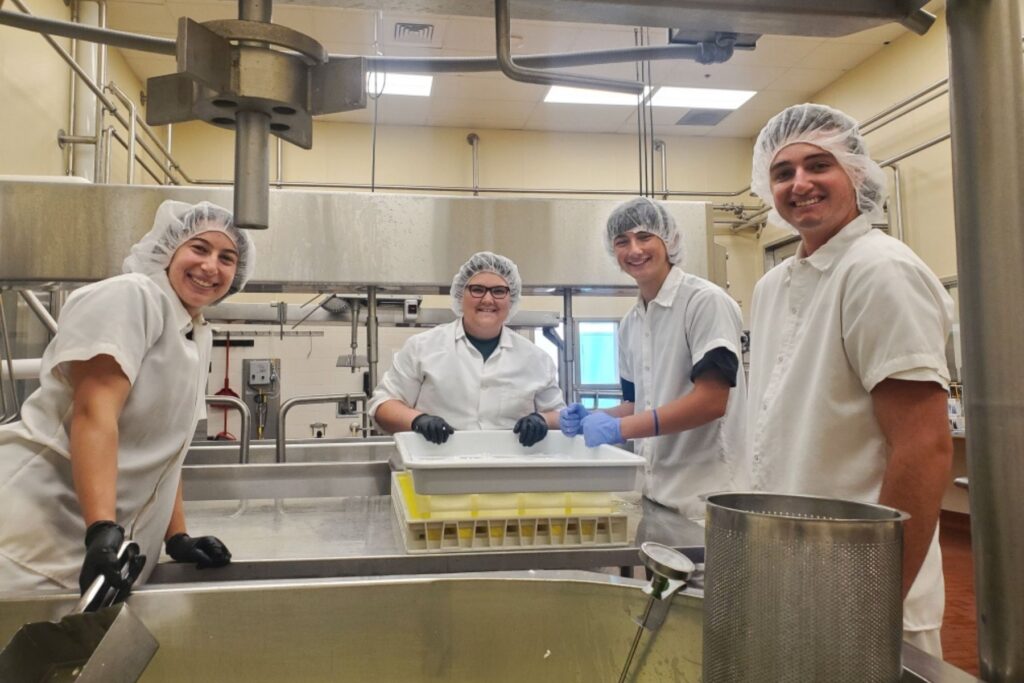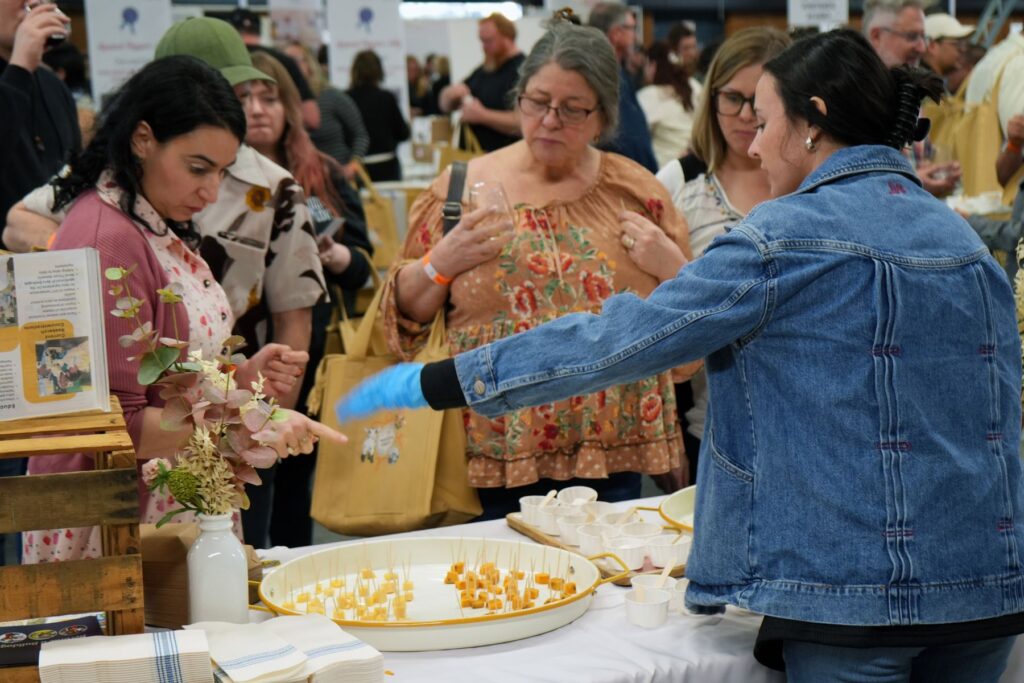
Cal Poly Creamery’s Cheesemaking: Science and an Art
Story by Aja Goare
Making cheese requires a lot of milk — and making milk involves an even greater volume of water. Foodprint, a non-profit organization dedicated to research and education on food production practices, estimates that a single pound of cheese requires 382 gallons of water to produce. Cow’s milk is mostly water; cheesemaking removes much of the water and concentrates the remaining fat and protein.
Dairy science is on full display at the creamery on the Cal Poly campus in San Luis Obispo, which is both a teaching laboratory and a licensed manufacturing plant. Since 1903, the dairy has been producing high quality cheeses that have earned widespread acclaim. Cal Poly dairy products are considered “farmstead,” meaning they are produced on site from the milk of the university’s own herd. At the dairy operated across the street from the creamery, Jersey and Holstein cows make up the herd. Products made with the milk of Jersey cows — known for their higher protein, calcium and butter fat — naturally have a creamier, richer flavor.
Jenna Bates and her fellow classmates create cheese that’s distributed to California grocery stores and restaurants. Jenna is the Student Manager of the Cal Poly Creamery and has a hand in making cheese, ice cream and other dairy products. It’s a learning experience for students, who manufacture, package, market and sell the products. “I’ve been involved with the cheesemaking from beginning to end,” says Jenna.
Two of these artisan cheeses — Triple Peak Brie and Highland Cheddar — were recently sampled by attendees of the 19th Annual California Artisan Cheese Festival in Santa Rosa. “It’s really rewarding to know how much people appreciate what we produce and enjoy it,” says Jenna, a third-year student majoring in agricultural systems. “I love how people talk about how much they love it.”
Jenna hadn’t originally planned to be so involved in the creamery, but the deeply gratifying experience of enjoying cheese made by her own hands keeps her here. The university’s trademark “learn by doing” approach is what inspires a love for cheesemaking among not only students, but also members of the community who attend the creamery’s cheese production classes. Cal Poly Research Associate Dimitri Genard says entry level cheesemaking is accessible and captivates many who try it.
“Like bread, it’s not actually hard to make cheese; it’s just a few ingredients and time,” says Dimitri, who oversees the pilot plan at the Dairy Products Tech Center. “It is hard to make really good cheese.”
According to Dimitri, paneer and ricotta are the easiest to learn. Brie and blue cheese are much more difficult due to the aging process. In the creamery’s community classes, which Dimitri instructs, participants learn the ins and out of making different cheese styles. For instance, the type of water used in making cheese is essential to an edible product. Cheese requires unchlorinated water to avoid harming the rennet and bacterial cultures used in the process. Reverse osmosis, de-ionized and distilled water are the best options, while bottled still, bottled and filtered water may be suitable for use.
Cheese is a science just as much as it is a beloved edible accoutrement. The complexities of flavor are influenced by factors such as the type and quality of milk, starter cultures, rennet coagulation, salt content, ripening conditions and microbial activity. With so many possible variations, the spectrum of cheese characteristics is unlimited — and for foodies, that’s a very Gouda thing, indeed.
Quick Cheese Bread
Recipe by Cal Poly Creamery
Makes 1 loaf
INGREDIENTS
- 1 cup shredded Parmesan, divided
- 3 cups all-purpose flour
- 1 tablespoon baking powder
- ¼ teaspoon cayenne (optional)
- 1 teaspoon salt
- 2 cups Highland or White Cheddar Cheese in ¼-inch cubes
- 1¼ cups whole milk
- 3 tablespoons butter, melted
- 1 large egg, beaten
- ¾ cup sour cream
PREPARATION
Step 1
Preheat oven to 350 degrees F. Spray 5×9-inch loaf pan with non-stick cooking spray, then sprinkle half the Parmesan evenly on bottom and sides of pan (Parmesan gives it a flavorful rich crust).
Step 2
In large bowl, whisk flour, baking powder, cayenne if desired and salt. Using a rubber spatula, mix in Cheddar, breaking up clumps until cheese is coated with flour. In medium bowl whisk together milk, melted butter, egg and sour cream. Using a rubber spatula, gently fold wet ingredients into dry ingredients until just combined (batter will be heavy and thick). Do not overmix. Scrape batter into prepared pan and spread to sides to level.
Step 3
Sprinkle remaining Parmesan over top of batter. Bake in center of oven until deep golden brown and toothpick inserted in center comes out clean, about 45–55 minutes. Check in several spots, in case toothpick hits a pocket of cheese, to ensure doneness. Cool in pan on wire rack at least 5 minutes; invert loaf from pan and continue to cool about 45 minutes for ease in cutting.



